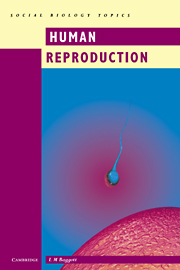Book contents
- Frontmatter
- Contents
- 1 Human reproductive strategies
- 2 Gamete production
- 3 Fertilisation
- 4 Implantation and pregnancy
- 5 Birth and lactation
- 6 Contraception
- 7 Human infertility: background and causes
- 8 Human subfertility: options and treatment
- 9 Ethical and moral considerations of fertility and infertility
- Index
7 - Human infertility: background and causes
Published online by Cambridge University Press: 05 June 2012
- Frontmatter
- Contents
- 1 Human reproductive strategies
- 2 Gamete production
- 3 Fertilisation
- 4 Implantation and pregnancy
- 5 Birth and lactation
- 6 Contraception
- 7 Human infertility: background and causes
- 8 Human subfertility: options and treatment
- 9 Ethical and moral considerations of fertility and infertility
- Index
Summary
In view of the increasing problems of world over-population, it may be surprising to learn that human fertility is relatively poor. Compared, for example, with rodents, reproduction in people is very inefficient, and the fact that there are so many of us is due to improved survival rather than reproductive success. Even in couples who have already conceived (i.e. are of proven fertility) the average monthly chance of the woman getting pregnant is only 20–25%, and just by chance about 10% of these fertile couples will fail to conceive during their first year of trying. It is only after at least this period of time, during which their family doctor will have probably explained to them carefully how to maximise their chance of conceiving, that they are referred to a specialist fertility clinic.
The complete inability to conceive a child – infertility – is very rare. This would only be the case, for example, if the woman had completely blocked Fallopian tubes or premature menopause, or if the man had a complete lack of sperm. Absolute infertility in both partners who are of reproductive age means that there are no treatment options open to them, and their only means of having a family would be to adopt or foster children. The anxiety of wondering whether they will be acceptable as foster parents or adopters can be as stressful as the treatment for infertility.
- Type
- Chapter
- Information
- Human Reproduction , pp. 72 - 80Publisher: Cambridge University PressPrint publication year: 1997



